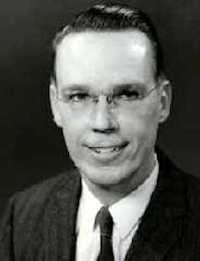Raymond F. Jones
Raymond F. Jones was the author of the science fiction novel This Island Earth, which was made into a film by the same name, which was one of the top-rated science fiction films of the 1950s. His short story, "The Alien Machine,” first published in the June 1949 edition of Thrilling Wonder Stories, was later combined with two other short stories, "The Shroud of Secrecy" and "The Greater Conflict,” and expanded his novel This Island Earth.
He wrote the short story “Rat Race,” which appeared in the April 1966 issue of Analog Science Fiction and Fact, and was nominated for a Hugo Award. His ”Correspondence Course,” first published in the April 1945 edition of Astounding Stories, was nominated for a Retro Hugo award for best short story.
A 1952 Tales of Tomorrow television program episode, titled "The Children's Room,” was based on a short story Jones wrote.
His short story, "Tools of the Trade", that appeared in the November 1950 issue of Astounding, was the first story dealing with 3D printing, although he called it "Molecular Spray" in his story.[1]
He published fifteen novels and his numerous novellas and short stories appeared in collections and classic science fiction magazines. Nine of his novels are in the public domain because the original copyright was not renewed. Those titles are: The Great Gray Plague, The Memory of Mars, Cubs of the Wolf, The Colonists, The Year When Stardust Fell, The Unlearned, The Alien, and Human Error, and a Japanese title 火星の記憶.
Jones was listed in the top 200 writers of all time in A Reader’s Guide to Science Fiction, published in 1979 by Avon Books.
Jones was born on November 15, 1915, in Salt Lake City, Utah, and was a member of The Church of Jesus Christ of Latter-day Saints. He died on January 24, 1994. He was married to Elaine Kimball from 1940 until her death in 1970. He married Lillian Wats in 1973.
He worked for the Weather Bureau and the Genealogical Society for many years and was active in genealogy work his entire life. He was a publications engineer for 15 years. In addition to writing science fiction, he also wrote about science.[2]
